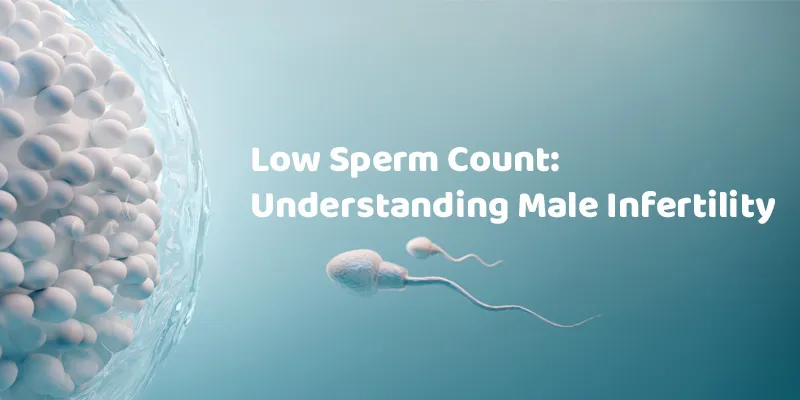The Root Causes of Low Sperm Count
What You Need to Know Regarding Causes of Low Sperm Count
Hey there! Let’s chat about male infertility. It’s a health concern that can affect a man’s ability to help his partner get pregnant. Yep, it’s a team effort, and sometimes things don’t go as smoothly as we’d like.
The Big Picture: Did you know that about 13 out of every 100 couples struggle to conceive naturally? Yep, it’s more common than you might think. Both men and women can face fertility challenges, and interestingly, in over a third of these cases, the issue lies with the man. Often, the culprit is either problems with sperm production or issues getting the sperm where they need to go.
How Does It Usually Work? Alright, let’s break it down. The male body is pretty amazing at creating these tiny, tadpole-like cells called sperm. When things are working as they should, these sperm are delivered into a woman’s body during ejaculation.
Here’s a quick tour of how the male reproductive system operates:
- Sperm Production: Sperm and the male hormone testosterone are produced in the testicles, which are housed in a skin pouch called the scrotum.
- Storage and Transport: Once produced, sperm move into a tube called the epididymis, located behind each testicle. Just before ejaculation, they move into another set of tubes called the vas deferens.
- The Big Moment: During ejaculation, the sperm mix with fluids from the prostate and seminal vesicles, creating semen. This semen then travels out of the body through the urethra and out of the penis.
For pregnancy to happen, these sperm need to travel through the female reproductive system and meet an egg for fertilization. Sounds simple, right? Well, it is, but it also requires everything from genes and hormone levels to environmental conditions to be just right.
Common Causes of Low Sperm Count (Male Infertility)
Now, let’s dive into some of the reasons why things might not be going as planned in the sperm department:
- Sperm Disorders: Sometimes, sperm may not develop properly, have an unusual shape, move incorrectly, or be produced in low numbers (known as oligospermia). In some cases, no sperm are produced at all (called azoospermia).
- Varicoceles: These are enlarged veins in the scrotum that can affect sperm production and quality.
- Retrograde Ejaculation: This occurs when semen enters the bladder instead of exiting through the penis during ejaculation.
- Immunologic Infertility: This happens when the body’s immune system mistakenly targets and damages sperm.
- Obstruction: Blockages in the tubes that sperm travel through can prevent sperm from being released during ejaculation.
- Hormonal Imbalances: Fluctuations or imbalances in hormone levels can impact sperm production and function.
- Medication and Lifestyle Factors: Certain medications, smoking, excessive alcohol consumption, and other lifestyle choices can lower sperm count and quality.
- Other Factors: Conditions like kidney failure, childhood infections like mumps, and chromosome or hormone issues can also contribute to infertility.
Facing challenges with fertility can be tough, but it’s essential to remember that you’re not alone, and there are many potential causes and treatments out there. If you or your partner are experiencing fertility issues, it’s always a good idea to talk with a healthcare professional. They can help pinpoint the issue and guide you toward the best course of action.
Varicoceles are enlarged veins located in the scrotum. They are found in about 16% of men overall and are even more prevalent in men experiencing infertility, accounting for about 40% of cases.
These swollen veins can impede proper blood drainage, potentially causing blood to flow back into the scrotum from the abdomen. This can elevate the temperature of the testicles, negatively impacting sperm production and leading to reduced sperm counts.
Retrograde Ejaculation Retrograde ejaculation occurs when semen travels backward into the bladder instead of being expelled through the penis during ejaculation. This phenomenon can occur due to the failure of nerves and muscles in the bladder to close properly during orgasm.
Although the semen may contain normal sperm, it cannot be released from the penis, hindering its ability to reach the vagina.
Several factors can contribute to retrograde ejaculation, including surgeries, medications, or neurological health issues. Common signs include cloudy urine post-ejaculation and reduced or “dry” ejaculation.
Immunologic Infertility In some cases, a man’s body produces antibodies that attack his own sperm. These antibodies are typically generated in response to injury, surgery, or infection, disrupting the normal function and movement of sperm.
While the exact mechanisms by which antibodies impact fertility remain unclear, they can impede sperm from reaching the fallopian tubes and fertilizing an egg. However, this is not a frequent cause of male infertility.
Obstruction Obstructions in the tubes through which sperm travel can hinder the release of sperm during ejaculation. Causes of these blockages can include recurrent infections, surgeries like vasectomy, inflammation, or developmental abnormalities.
Any segment of the male reproductive tract can potentially be obstructed, preventing sperm from exiting the body during ejaculation.
Hormones Hormones produced by the pituitary gland play a crucial role in instructing the testicles to produce sperm. Extremely low hormone levels can result in poor sperm development.
Chromosomes Sperm carry half of the DNA required for fertilization. Alterations in the number or structure of chromosomes can impact fertility. For instance, missing segments in the male Y chromosome could affect fertility.
Medication Certain medications can alter sperm production, function, and delivery. These medications are often prescribed to treat conditions such as arthritis, depression, digestive issues, anxiety, high blood pressure, infections, and cancer, among others.
Diagnosis
Diagnosing the causes of male infertility can be challenging. Issues usually center around sperm production or delivery. The diagnostic process typically begins with a comprehensive medical history and physical examination. Additional tests, such as blood work and semen analysis, may also be conducted.
History and Physical Exam During the initial consultation, the healthcare provider will review the patient’s medical and surgical history, paying particular attention to factors that might affect fertility. Lifestyle factors, such as alcohol and drug use, exposure to radiation, heavy metals, and pesticides, will also be assessed.
The physical examination will focus on the reproductive organs, including the penis, epididymis, vas deferens, and testicles, to identify potential abnormalities such as varicoceles.
Semen Analysis A semen analysis is a standard laboratory test that assesses sperm production levels and functionality, including movement (motility). If abnormalities in sperm numbers are detected, the test is typically repeated for confirmation. The results can provide valuable insights into a man’s fertility potential and guide treatment decisions.
Transrectal Ultrasound A transrectal ultrasound may be ordered to examine the structures surrounding the ejaculatory ducts for abnormalities or blockages.
Testicular Biopsy If a semen analysis reveals very low sperm counts or absence of sperm, a testicular biopsy may be recommended. This procedure can be performed under general or local anesthesia and involves obtaining a small tissue sample from each testicle for microscopic examination.
The biopsy serves dual purposes: identifying the underlying cause of infertility and collecting sperm for assisted reproduction techniques like in vitro fertilization (IVF).
Hormonal Profile Hormonal assessments may be conducted to evaluate testicular function and rule out significant health issues. For instance, elevated levels of follicle-stimulating hormone (FSH) may indicate a pituitary gland attempting to stimulate the testicles to produce sperm without success.
Treatment The appropriate treatment for male infertility depends on the underlying cause. Many issues can be addressed with medications or surgical interventions, enabling conception through natural intercourse. Treatment options are categorized into non-surgical therapy, surgical therapy, and treatment for unknown causes of male infertility.
Non-surgical Therapy for Male Infertility Anejaculation (dry ejaculate) is a condition where no semen fluid is released during orgasm. It can be caused by spinal cord injuries, previous surgeries, diabetes, multiple sclerosis, congenital abnormalities, or psychological factors. Initial treatment often involves medication.
If unsuccessful, alternative methods such as penile vibratory stimulation (PVS) or rectal probe electroejaculation (RPE) may be employed to induce ejaculation. Sperm retrieval directly from the testicle may also be considered.
Genital Tract Infection Genital tract infections are seldom linked to infertility but can occasionally be diagnosed through semen analysis showing elevated white blood cell counts.
These infections may produce excessive reactive oxygen species (ROS), which can damage sperm and reduce fertilization potential. Treatment usually involves antibiotics or anti-inflammatory medications.
Hyperprolactinemia Hyperprolactinemia refers to elevated levels of prolactin hormone produced by the pituitary gland. This condition can contribute to infertility and erectile dysfunction. Treatment options depend on the underlying cause, with drugs or surgery being utilized to address pituitary tumors if present.
Hypogonadotropic Hypogonadism Hypogonadotropic hypogonadism is a condition where the testicles fail to produce sperm due to inadequate stimulation by pituitary hormones, stemming from issues within the pituitary or hypothalamus.
It can manifest as congenital (present from birth) or acquired (developing later in life) forms. Diagnostic evaluations may include MRI scans to assess the pituit.

A graduate of Computer Science and Information Management Technology. Diploma – Caregiving, Certificates – Dementia and Diabetes Awareness and Management. A researcher, blogger, songwriter, singer and acoustic guitarist. Born in an environment where natural talents such as healing are imparted at our natural birth. This natural talents of healing is the result of our genetic inheritance and the training from family environment.















